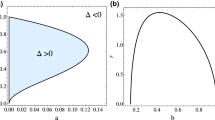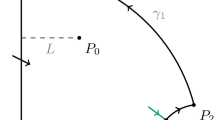Abstract
In this work, we study the qualitative properties of the model proposed by Selkov Eur J Biochem 4: 79–86 (1968) for the description of the glycolytic oscillations. First we show that the Selkov’s model can be put in form of a Newton’s equation, thus allowing to define a pseudo-energy. Then, we show without imposing additional conditions that the limit cycle, if it exists, it is unique and globally attractive, thus precluding the possibility of multi-rythmicity. Finally, based on energetic and geometric considerations, we investigate the global properties of the unique equilibrium (idest of the arrest of the oscillations). Some biochemical remarks on the relevance of the uniqueness of sustained oscillations end the work.
Similar content being viewed by others
References
Keener J., Sneyd J.: Mathematical Physiology. Springer, Heidelberg (2003)
Alberts B. et al.: Molecular Biology of the Cell. Garland, New York (1994)
Duysens L.N.M., Amesz J.: Fluorescence spectrophotometry of reduced phosphopyridine nucleotide in intact cells in the near-ultraviolet and visible region. Biochim. Biophys. Acta 24, 19–26 (1957)
Ghosh A., Chance B.: Oscillations of glycolytic intermediates in yeast cells. Biochem. Biophys. Res. Commun. 16, 174–181 (1964)
Ibsen K.H., Schiller K.W.: Oscillations of nucleotides and glycolytic intermediates in aerobic suspensions of Ehrlich ascites tumor cells. Biochim. Biophys. Acta 131, 405–407 (1967)
Poulsen A.K., Petersen M.O., Olsen L.F.: Single cell studies and simulation of cellcell interactions using oscillating glycolysis in yeast cells. Biophys. Chem. 125, 275–280 (2007)
Yang J.H. et al.: Glycolytic oscillations in isolated rabbit ventricular myocytes. J. Biol. Chem. 283, 36321–36327 (2008)
Goldbeter A., Lefever R.: Dissipative structures for an allosteric model. Bioph. J. 12(10), 1302–1315 (1972)
Goldbeter A.: Biochemical Oscillations and Cellular Rhythms: The Molecular Bases of Periodic and Chaotic Behaviour. Cambridge University Press, Cambridge (1996)
Goldbeter A.: Biological rhythms as temporally dissipative structures. In: Rice, S.A. (eds) Special Volume in Memory of Ilya Prigogine Advances in Chemical Physics, vol 135, Wiley, New York (2007)
Selkov E.E.: Self-oscillations in glycolysis. Eur. J. Biochem. 4, 79–86 (1968)
Zhang Z.: Proof of the uniqueness theorem of generalized Lienard’s equations. App. Anal. 23, 63–76 (1986)
Kuang Y., Freedman H.I.: Uniqueness of limit cycles in Gause-type models of predator-prey systems. Math. Biosci. 88, 67–84 (1988)
Hwang T.-W., Tsai H.-J.: Uniqueness of limit cycles in theoretical models of certain oscillating chemical reactions. J. Phys. A: Math. Gen. 38, 8211–8225 (2005)
Edelstein-Keshet L.: Mathematical Models in Biology. SIAM, Philadelphia (2005)
Perko L.: Differential equations and dynamical systems. Springer Springer, Heidelberg (1991)
Author information
Authors and Affiliations
Corresponding author
Additional information
This work is dedicated to my dear friend Prof. Gigi Beghi, of Padua University, on his retirement: I started to work to this project when I was guest of his department.
Rights and permissions
About this article
Cite this article
d’Onofrio, A. Uniqueness and global attractivity of glycolytic oscillations suggested by Selkov’s model. J Math Chem 48, 339–346 (2010). https://doi.org/10.1007/s10910-010-9674-6
Received:
Accepted:
Published:
Issue Date:
DOI: https://doi.org/10.1007/s10910-010-9674-6




